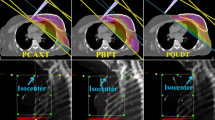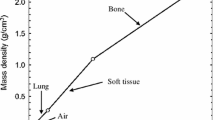Background and Purpose:
Dose homogeneity is one of the objectives during computer planning of postoperative radiotherapy of the conserved breast. For three-dimensional (3-D) optimization of the dose distribution using serial CT scan images, suitable volumes have to be delineated. The purpose of this study was to develop a computer-generated delineation of a plan optimization volume (POV) and an irradiated volume (IV) and to automate their use in a fast dose homogeneity optimization engine.
Patients and Methods:
Simulation was performed according to our standard procedure which involves the positioning of a lead collar around the palpable breast to facilitate the definition of gantry angle, collimator angle and field aperture for tangential wedged photon beams. In a change to the standard procedure an anterolateral radiograph was taken with its axis orthogonal to the central plane of the two tangential half-beams. Images from a serial CT scan were acquired in treatment position, and the geometric data of the three simulated beams were used by a computer program to generate the POV and IV. For each patient, weights of wedged and unwedged beams were optimized by either human heuristics using only the central slice (2-D), the whole set of CT slices (3-D), or by a computer algorithm using the POV, IV and lung volume with constrained matrix inversion (CMI) as optimization method. The resulting dose distributions were compared.
Results:
The total planning procedure took, on average, 44 min of which < 7 min were needed for human interactions, compared to about 52 min for the standard planning at Ghent University Hospital, Belgium. The simulation time is increased by 2–3 min. The method provides 3-D information of the dose distribution. Dose homogeneity and minimum dose inside the POV and maximum dose inside the IV were not significantly different for the three optimization techniques.
Conclusion:
This automated planning method is capable of replacing the contouring of the clinical target volume as well as the trial-and-error procedure of assigning weights of wedged and unwedged beams by an experienced planner.
Hintergrund und Ziel:
Dosishomogenitität ist eines der Ziele bei der Planung für die Strahlentherapie nach brusterhaltender Operation. Für die dreidimensionale (3-D) Optimierung der Dosisverteilung mit Hilfe serieller CT-Schnitte müssen passende Volumina ermittelt werden. Ziel dieser Studie war, eine computergesteuerte Erstellung des optimierten Planungszielvolumens (POV) und des bestrahlten Volumens (IV) zu entwickeln und ihren Einsatz in einem schnellen Rechner zur Optimierung der Dosishomogenität zu automatisieren.
Patienten und Methoden:
Die Simulation wurde nach unserem Standardverfahren durchgeführt, bei dem eine Bleikette um die tastbare Brust gelegt wird, um die Festlegung von Gantry-Winkel, Kollimatorwinkel und Feldgrößen für tangentiale Keilfilterfelder zu erleichtern. In einer Abwandlung des Standardverfahrens wurde ein anterolaterales Röntgenbild aufgenommen, dessen Achse orthogonal zur Zentralebene der beiden tangentialen Strahlen verläuft. Serielle CT-Schnitte wurden in Behandlungsposition aufgenommen, und mit den geometrischen Daten der drei simulierten Felder erstellte ein Computerprogramm POV und IV. Für jede Patientin wurde die Wichtung für die Strahlenfelder mit und ohne Keilfilter optimiert, indem manuell nach menschlichem Ermessen nur die zentrale Schicht (2-D) bzw. alle CT-Schichten herangezogen wurden (3-D). Alternativ wurde ein Computeralgorithmus eingesetzt, der POV, IV und das bestrahlte Lungenvolumen nach der Methode der Constrained Matrix Inversion (CMI) optimiert. Die so erzielten Dosisverteilungen wurden verglichen.
Ergebnisse:
Das gesamte Planungsverfahren dauerte durchschnittlich 44 min, von denen < 7 min für menschliche Interaktion benötigt wurden, im Vergleich zu rund 52 Minuten beim Standardverfahren der Universitätsklinik Gent/Belgien. Die Simulationszeit ist um 2–3 min länger. Das Verfahren liefert 3-D-Information über die Dosisverteilung. Dosishomogenität und minimale Dosis innerhalb des POV und maximale Dosis innerhalb des IV unterschieden sich bei den drei Optimierungstechniken nicht signifikant.
Schlussfolgerung:
Dieses automatisierte Planungsverfahren kann sowohl das Festlegen des klinischen Zielvolumens ersetzen als auch Näherungsmethoden erfahrener Planer.
Similar content being viewed by others
Author information
Authors and Affiliations
Corresponding author
Rights and permissions
About this article
Cite this article
Van Vaerenbergh, K., De Gersem, W., Vakaet, L. et al. Automatic Generation of a Plan Optimization Volume for Tangential Field Breast Cancer Radiation Therapy. Strahlenther Onkol 181, 82–88 (2005). https://doi.org/10.1007/s00066-005-1310-1
Received:
Accepted:
Issue Date:
DOI: https://doi.org/10.1007/s00066-005-1310-1




